-
收藏模板
- 模板信息
- 更新时间:2023-09-08
- 字数:约20205字
- 页数:约18页
- 格式:.doc
- 推荐版本:Office2016及以上版本
- 售价:5 金币
您可能喜欢的文档
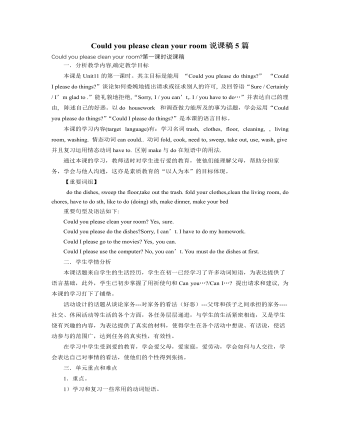
人教版新目标初中英语八年级上册Could you please clean your room说课稿5篇
三、教学准备 复习动词短语,并且预习生词, 游戏用的卡片 小奖品四、说教学方法与手段1.口语教学,在真实的语境下进行对话交际,复习旧知识,认识新事物,学习新内容。2.单词教学游戏化,寓教于乐,让学生学得开心,记得舒心。3. 利用信息沟活动,给学生设置了信息差,激发了学生的询问欲望,真正使语言起到了交流思想的作用。4.听说读写全面训练,从在听说的基础上,发展读写的技能。本节课着重写的能力,让学生从听写单词到看图写句子,由简到难,循序渐进。5.小组合作,师生对话,生生对话。五、说教材处理与学法指导1.将教材内容分为三部分。第一部分为口语操练为主,完成Section B,3,在复习旧句型的前提下学习Could you please clean your room?并能熟练进行对话。2.第二部分是听力练习,训练学生对新学单词的听辨能力和从对话中获取信息并作好记录的能力。4.第三部分是一个写的练习,是对上一节课的语法聚焦的巩固和提高,也是第二部分口头表达的延伸,是学生书面表达的起步。
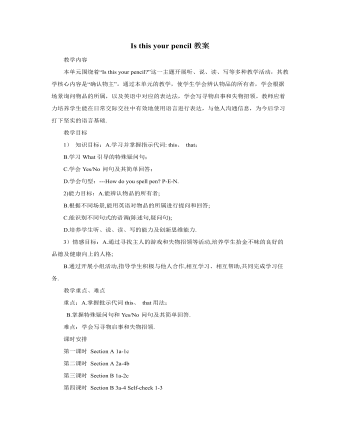
人教版新目标初中英语七年级上册Is this your pencil教案
T: Please look at the pictures and learn the new words.(用多媒体展示新单词效果较好。)1.at prep. 在(里面或附近);在(点刻);2.theart.表示特指的人、物、事或群体 3.lostadj.丢失的;遗失的4.Found adj. (find的过去式、过去分词)找回的5.lost and found 失物招领6.please adv.请7.school n. 学校8.a set of一套;一副(Teach students to read the words.)2. Practice the new words. (事先录制一段短的听力,让学生通过听的训练来强化所学的新单词,并为学习写寻物启示和失物招领作好准备。)T: Please listen to a short passage twice then fill the blanks using the words we learned.(Show students a short passage and play the recording for the students to listen.)There are many things in (1)_____________________in my (2)__________. Look, here’s (3)_________keys. Is this yours? (4)__________call Jim (5)___________753-2289.Typescript:There are many things in the Lost and Found in my school. Look, here’s a set of keys. Is this yours? Please call Jim at 753-2289.
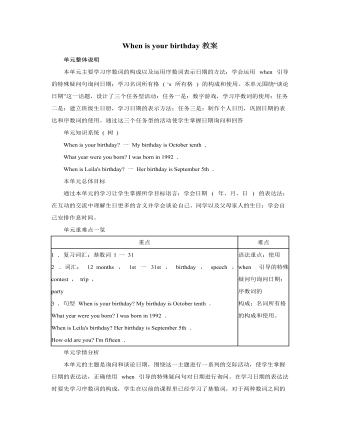
人教版新目标初中英语七年级上册When is your birthday教案
本单元主要学习名词所有格 ('s 所有格 ) 的构成和使用。在初次接触 “ 名词所有格 ” 时,学生较难理解的可能是 “ 所有格 ” 这个名称,对于它的构成,学生也许会觉得较容易。教师可通俗地告诉学生 “ 所有格 ” 的意思是表示 “…… 的 ” ,这样学生反而容易接受。在使用 “ 名词所有格 ” 形式时,学生容易犯错误或混淆的主要是:将这种一 's 构成形式与 is 的缩写形式混淆,如: My father's name's Jin Zhi .,可以这样告诉学生:名词所有格的后面一般应接名词;勿将这种一 's 结构盲目套用与人称代词上,代替物主代词使用,如 He's father's name is Li Cheng 。在教学初期,可不讲授名词所有格的其它形式,待时机成熟,再向学生介绍复数名词所有格形式的结构一 ' ,如: the students' bikes 。 Self Check 教学内容 Self Check( 教材 P52) 教学目标 知识与能力 复习词汇 birthday , date , month , January , February , March , April , May , June , July , August , September , October , November , December , date , birth , age , old , speech . contest . trip , party , event , an , festival , pop , concert , chorus , lecture , music ;引导学生复习、巩固“询问和谈论日期”的目标语言并运用所学知识安排活动。
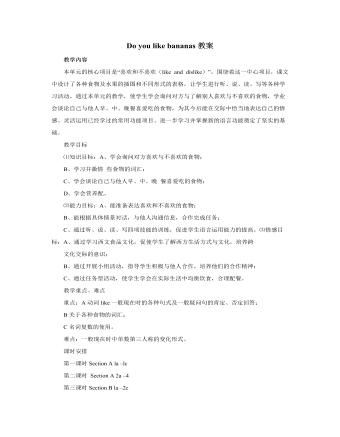
人教版新目标初中英语七年级上册Do you like bananas教案
教学目标 ⑴知识目标:A、学会询问对方喜欢与不喜欢的食物; B、学习并激情 些食物的词汇; C、学会谈论自己与他人早、中、晚 餐喜爱吃的食物; D、学会营养配。 ⑵能力目标:A、能准备表达喜欢和不喜欢的食物; B、能根据具体情景对话,与他人沟通信息,合作完成任务; C、通过听、说、读、写四项技能的训练,促进学生语言运用能力的提高。⑶情感目标:A、通过学习西文食品文化,促使学生了解西方生活方式与文化,培养跨 文化交际的意识; B、通过开展小组活动,指导学生积极与他人合作,培养他们的合作精神; C、通过任务型活动,使学生学会在实际生活中均衡饮食,合理配餐。 教学重点、难点 重点:A动词like一般现在时的各种句式及一般疑问句的肯定、否定回答; B关于各种食物的词汇; C名词复数的使用。 难点:一般现在时中单数第三人称的变化形式。
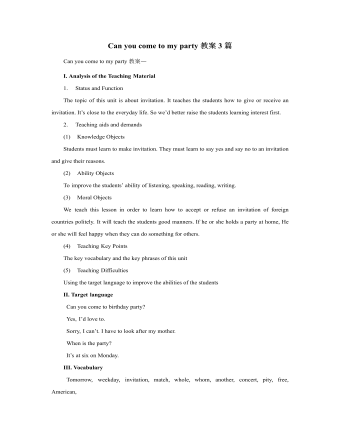
人教版新目标初中英语八年级上册Can you come to my party教案3篇
Step 3 (3b)First, tell the students when we talk about our future plans, we often use: I’m+verb+ing When we talk about what we must do, we use have to. Ask the students to fill in the blanks in 3b. The answers are: shopping, go to see, a test, I’m going, my family. Step 4 (3c)Let the students write an e-mail message to a friend. Say why you can’t visit next. Before the exercise, ask the students to give some possible answers and write them on the blackboard. So the students will feel easy to finish the writing exercise. After they finish it, Let them to correct it in groups first. Each group chooses theirs best one to read in front of the whole class. Step 5 ( planning a party )First read the conversation in the box together. Then ask the students to turn to page 88.Write down everything you have to do next week. Write in all the things you have to do . Ask the students to look at the list. Ask them “What day are you free?” This is when you can have your party. Step 6 (Self check 1 )Let the students to fill in the blanks with the words given. Change the forms of the words if possible. Then make their own sentences. The answers are: visit, playing, have to, study, comeStep 7 (Self check 2)Imagine you are Marie. Read the information and look at your schedule. Write replies to the invitation.
- 查看更多相关Word文档
Could you please clean your room教案3篇
Could you pleaseclean your room?教案一
Could you please clean your room?Period 1
一、 教学内容Section A 1a----1c
二、 教学目标
1.学习词汇do the dishes, make the bed, take outthe trash, fold the clothes, do the laundry, sweep the floor, clean the livingroom.
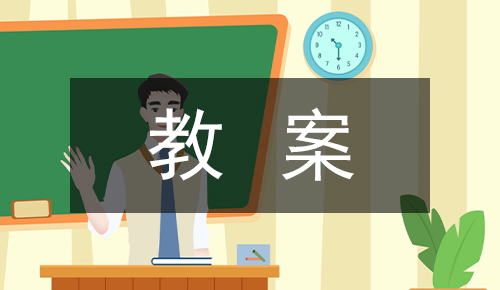
2.句型 Could you please clean your room? Yes,sure.
三、 教学准备学生预习本单元所有的词汇多媒体课件活动表奖品
四、 教学过程
Pre-task
1.Warming up
Enjoyourselves. Watch cartoon Cinderella. 看动画片段《灰姑娘》导如入本课话题和新词汇“chores”美丽善良的鬼姑娘因继母的嫉妒,每天得做所有的家务。片段的主题使学生联想到本课的话题。
2.learnnew words and phrases
Look!What is she / he dong? 看图学习动词词组do chores, do the dishes, make the bed,take out the trash, fold the clothes, do the laundry, clean the living room.
3.Guessing game.What is she doing ?
4.Pair work. 1a, Do you do these things at home? Write “Y” for “yes” and “N” for “no”.
5.Listening . 1b , Peter’s chores or Mom’s chores?
理解目标语Could you please clean your room? Yes,sure.
Write “M” for Mom’s chores, “P” for Peter’schores in the chart.
6.Pairwork
Lookat the picture,Ask your partner to do the chores that you see.
7.InterviewWho is the most able at home?
1)What chores do you do at home? How often do youdo the chores? Work in four, intervieweach of the students in the group, fill in the chart.
2)Then one student make a report to the class. “In my group…. Does the dishesevery day,…We think … is the most able one in our group.”
3)颁奖。给每个小组里的最能干者发奖。适时给学生爱劳动,爱父母的教育
8.总结本节课的教学重点。
9.Homework
Readthe words and phrases you learn today.
makea dialogue between you and your parent about doingthe chores.
活动表见PowerPoint 16、17、24、25。
五.教学反思
本节课主要谈论家务,话题贴近生活,,,在热身阶段, 以灰姑娘的动画片段导入动词词组,猜图游戏使词汇得到巩固,为下面的活动做好铺垫。新词汇结合学生的生活实际, 掌握运用target language礼貌提出请求, 并使学生受到爱劳动的教育..是本课的重点.。
Couldyou please clean your room?
Period2
一、 教学内容Section A 2a-4
二、 教学目标
1. 词汇:stay out late, work on the computer,get a ride, use the car, go to a meeting.
Hateto do /dong sth 。区别make与do的用法
2. 礼貌地征求许可:
CouldI please use your computer? Sorry, you can’t..
CouldI please watch TV?Yes, you can. But you have to clean your room first..
3.表达看法:
Ilike doing dishes because it’s relaxing, but I hate to do…because it’s boring.
三、 教学准备课件卡片小奖品
四、 教学过程。
1. Warming up
Game“Chain drill”.
运用上节课的target language“Could you please do…?”依次问答,其中的动词短语不能重复 ,复习动词短语。
2.Fillin the blanks with “make”and ”do”. 3a
3.Choresthat you like or dislike,3b
1) 呈现 like doing/to do, hate doing
2)Make a list of chores that you like and dislike.
3)Pairwork.谈论喜欢和不喜欢的家务,并表达自己的看法。
A:Doyou like doing dishes?
B:Yes,I like …because it’s relaxing,
No,I hate to do…because it’s boring.
4.Listening. 2a
1)Peterask his father if he can do four things. Check “yes” or “no”
2)Listenagain, Why does Peter’s father say “no”
Drawlines to the reasons in the chart.
5. Present target language
由听的活动2a 引入target language:
A: Could I please get a ride? B:Yes, you can.
A: Could I please get a ride? B:Sorry, you can’t, I have to go to a meeting.
6. Game.Sorry! I can’t!
Playthe game in 4.
7.Groupwork. (小组为灰姑娘动画片段配音)
(One day, the king invited all the girls to the great party. Herstep mother and her two sisters were going, She wanted to go very much, so sheasked her mother“…?” and what’s her mother’s answer?
“Could I go to the party? No, you can’t.? / Sure, you can. Butyou have to do all the chores first. Hahaha!…”)
8.Who’s the luckiest?
1)一个学生扮演仙女,其他学生展开想象,向仙女礼貌地提出自己的梦想. 请求帮助;运用target language “Could I please…?或者Could you please...?”
2)看仙女帮谁实现的梦想最多,选出前几名,那就是最今天的幸运之星。颁奖。
3)德育渗透:
Isthere really a fairy in the world? We must try our best to make our dreams cometrue.
9.Grammar focus
10.Homework.
CouldI go to the party?The concert? / the football game?…
假如今晚你想去看球赛或者音乐会或做其他你想做的事,你请求父母的许可。写一段对话。
教学反思
本课以灰姑娘的故事为线索,围绕“chores”这个话题, 礼貌地征求对方的许可。以游戏导入,复习提出请求的句型Could you please …?谈论喜欢和不喜欢的家务,从听的活动自然过渡到本课的target language“Could I ..? ”,接着,为灰姑娘想参加舞会而被继母拒绝的无声片段的配音,为学生运用目标语提供了一个趣味平台。“幸运之星”的活动,每个学生向仙女提出帮助实现梦想,让学生熟练地综合运用Section A 部分的target language。最后渗透德育,,启发学生走向成功光有梦想不够,惟靠自己的努力!
Couldyou please clean your roomPeriod 3
一、教学内容Section B 1a-2c
二、教学目标
1.学习词汇 invite my friends to …,buy some drinksand ,snacks, borrow some money r, teenager disagree
2.掌握句型 .Could you please buy some drink andsnacks? Sure. / Yes, I can.
Could I borrow youmoney? Yes, you can.. Sorry, you can’t.
3.难点; 综合的运用单元的目标语针对实际情景解决问题.
三、教学准备
复习动词短语,并且预习生词, 游戏用的卡片小奖品
四、教学过程
1. 游戏.
学生两人一组,代表所在的大组, 相对而立, 老师展示课前准备好卡片,卡片上写着动词词组, 一学生表演动作,另一学生在十秒内猜测词组, ,根据猜对的词组个数,评出挑战成功的组. 这个游戏的目的是复习所学的动词短语..打好脚手架架.
sweepthe floor, fold the clothes, clean the floor, cook, make the bed, buy somedrinks and snacks,take out the trash, wash the car, invite your friendsto …等,
2.Discussion
(在屏幕上展示出刚才的动词短语) .,
1) 1a What can teenagers ask their parents to do? What do parentsask their teenagers to do? 学习用I agree/ disagree 表示自己的观点.
T:Come to the front ,talk about your ideas.(.这个任务地目标运用词汇进行表达,同时渗透了对学生爱的教育,,爱父母,爱家庭,爱劳动.)
A:Ithink teenagers …
B:Iagree./ I don’t agree(disagree). I think …
2).Sally’s weekend.
Ask:What chores does Sally do on weekends? What do you think of Sally? Then Showsome photos of Sally.
3.A game
Practicewith“Could you please…?”“Could I …?”将课前准备的双色卡片(如:红/蓝)分发给学生,卡片以字母编号,同一编号的有两张,上面有简笔画,规定获得红色卡片的学生先发问,根据卡片上的简笔画回答。
Example:
A:Could you please clean the floor?
A2:Sure! But I have to do my homework first.
B: Could I have a digitalcamera?
B:Sorry, you can’t. It’s too dear..
Or
B:Could I borrow some money from you?I want to buy a camera. It’s 2000RMB.
B: Sorry, I don’t have so much money.
4.Listening.
1)2aListen and check the things you hear..
2) 2b Listen again., and fill in the chart.
Whatis Sandy’s mother going to do ?
Whatis Sandy going to do?
Whatare Sandy and Dave going to do?
3)Listen toHappy birthday song..
5.Group work. Make a telephone invitation and ask for help. (小组继续比赛)
If you are sandy,, you want to invite you goodfriends to come to you party, and you need their help, too..Make a list ofthings you want to buy and to do first, then discuss in group,act it out..
让学生进行评价.评出有特色的“最佳表演”“最佳创意”“最…”小组,给予奖励。
6.总结本课的target language.
7.Homework.
Inviteyour friends to have a picnic with you, and ask for their help to prepare forthe picnic.. make a conversation.
教学反思
如何激发学生的兴趣, 使他们主动积极地参与活动,开展合作学习, 使课堂充满活力,使设计的每个任务产生实效, 这是任务型教学中的首要问题. 本节课开展小组竞赛, 任务链为:游戏热身( 巩固词汇), 讨论(学习运用句型), 表演(综合运用)等活动, 逐步递进, 从简到难, 从谈论Sally 的周末, 到谈自己一周里所干的家务,电话邀请和请求帮助 ,都是来自现实生活的话题, 极具真实性. 为学生综合表达提供了丰富的素材.让学深入、让学生参与过程的评价体现了以学生为主体的原则.
Couldyou please clean your room?Period 4
一、教学内容Section B3a –3c & self check
二、教学目标
1.学习词汇 take care of, forget to do, feed thedog, move to a new house, take the dog for a walk
2.学习写留言条获得朋友的帮助。.
3.难点; 综合运用单元目标语,针对实际情景解决问题.
三、教学准备复习词汇和句型,预习3-4,some paper
四、教学过程
1. warming up.
1) Memory challenge. 复习词汇和Target language
Tom’sweek.
Studentslook at the chart for only one minute,then the chart is covered, Students saywhat Tom does on weekdays and weekends.
2)Do1 inself check
2. . 3a Reading
1).Question: Do you have a dog or a bird ?
How do you take care of it? Discus in pairs.
2)Readthe e-mail message. Quickly . in 3a.
Whatdoes Thomas ask Nancy to do?
3)词汇分类.Which things are about food? Cleaning? Exercise?
4)学习写求助的留言的方式法.
3.Help Sandy Complete the e -mail message. (3b and 3c),展示优秀的作品.
4.Groupwork. “Help Wanted”
1)给出不同的话题,让每个小组抽取一个话题,合作讨论, 写留言条寻求帮助.
2)然后将条子贴在黑板上,让每组学生代表上来,找到自己能做的事,并和那个小组进行对话表演 .
5.总结.
6.homework
ReviseUnit 11, complete the message in2ofself check.,
教学反思
本节课在复习单元词汇和句型的基础上, 进一步学会运用目标语进行写的训练, 是能力目标的体现. 不同的话题拓展到生活的各个方面, ,给学生综合运用目标语,提供了一个广阔的平台, 使学生能运用语言知识解决实际问题.
Couldyou please clean your room?Period 5
课外阅读和,知识的拓展)(教案略)
Could you pleaseclean your room?教案二
教学目标:
1.学习谈论家务
2.提出请求;申请许可
3.能够口头或书面描述日常活动
情感目标:
培养学生热爱劳动,帮助他人的传统美德。
教学重点和难点:
1. "Could " for polite requests
2. "Could" for permission.
3. "Make" versus "do"
课前准备:
1.教学器材:Recorder; tape, computer, pictures, acourseware, handout, etc.
2.教学课件:Cartoon pictures; Flash on PC
教学设计:
学习内容 | 学生活动 | 教师活动 |
表示做家务的动词及短语:do the dishes; sweep the floor; take out the trash; make the bed; fold the clothes; do the laundry; clean the living room; etc. | 1.通过对话过程了解、体会,并最终掌握日常家务、杂物的表达法。 | 引导、启发、教授需学内容。 |
2.提出请求;申请许可: "Could " for polite requests "Could" for permission. | 2.通过听录音、回答问题,了解、体会并最终掌握句型。 | 放录音;启发、提示问题及答语。 |
3.阅读→迁移→辨析make及do(读、写、文化差异)。 | 阅读短文→迁移前面听力感应→辨析文中所缺行为动作make及do→填入适当动词并使之形成一篇完整文段。 | 3.引导、提示动词辨析;带读课文或放录音。提示文化差异。 |
能够用口头或书面描述日常活动及家务:buy some drinks and snacks; borrow some money; invite my friends to a party; go to the store; use your CD player; etc. | 4.利用本单元所学日常活动及做家务的动词和短语,就图片或文字所提供的信息进行讨论。可发散思维,或用学过的知识,或用课外知识,扩展话题。 之后,整理词语,写成文段。 | 4.检查学生讨论图片或文字的情况——句型、短语、动词形式是否正确;指导并落实学生写作情况。 |
教学过程设计:
Task One: Talk about chores
Goal:Learn theexpressions of daily chores by means of discussion
Step 1. Brainstorm:What chores do you have at home? Who often does the chores?
How often do your family do them? (Ask a fewstudents to answer the question orally.)
Step 2. Do you dothese chores at home: Section A: 1a
Step 3. Help thestudents form the groups of three people and make sure one is the kid, theother two are mother and father.
Chores | Who | How often |
do the dishes | mother | every day |
cook | father | twice a month |
… | … | … |
… | … | … |
… | … | … |
Step 4. Ask the"kid" in each group to fill in the chart according to the realsituation in his or her home.
Step 5. Is it fair foreveryone in the family? Try to role-play the discussion in groups.
E.g. Kid: Could you please cook twice aweek, dad? Mom is too tired. She needs help.
Father: Sure. But could youwash your own clothes?
Kid: Sorry, I cant. I dont havetoo much time.
Task Two: Make polite requests and askfor permission
Goal: Learn the structures of makingrequests and asking for permission by means of listening
Step 1. Brainstorm:What kind of difficulties will a person, who is hurt at school?
(Write the students ideas on the board)
Step 2. Listen to thetape, trying to follow the structures in it: Section A: 1b; 2a & 2b
Step 3. Ask a studentto pretend Jack who was hurt, and tell him to ask for helps from his classmatesin the front. The rest of the class try to give him differentanswers.
E.g. --- Maria, could you please move thechair for me?
---Sure, Id love to.
---Annie, could you please help me takeEnglish notes?
---Sorry, I cant. I have to goto the teachers office first. I can help you later.
Task Three: Express daily chores inshort passages by means of talking, reading and writing
Goal: Have the ability of expressingdaily chores not only orally but also in written English
Step 1. Help thestudents form groups of three.
Step 2. Role-play theconversations in groups.
Step 3. Present someconversations to the class.
E.g. Tom: Could I have an ice cream?
Father/Mother: …
Tom: Could I take the small planethere?
Father/Mother: …
Step 4. Learn moreexpressions of daily chores by reading an e-mail, answer it and try to write anew one: Section B: 3a, 3b &3c.
教学点评与反思:
一、设计思路:
课前讨论为任务一的完成做了铺垫。接着,通过听,了解句型,并初步掌握如何表达谈论家务,提出请求及申请许可。最后,学生又通过阅读进一步巩固本单元所学的句型,并通过迁移进行仿写,最后以自主写作为最终目标。这样,学生既学会了如何描述日常家务或活动,又可以学会发散思维,以扩展知识。同时,学生的口头及书面表达能力也可随之提高。
任务型课程的设计要自始至终体现任务的要求与特点,尤其要确保任务的设计与完成是从简单重复逐步过渡到真实或接近真实。基于这一要求与特点,通过完成这一系列任务,既使学生学会了如何表达日常家务,提出请求或申请许可;又渗透了对学生的教育:通过完成任务培养学生热爱劳动的美德。
二、课后反思:
不足之处:虽说课堂上以学生为主体了,但老师的主导作用也需体现:本节课教师启发的还不完全到位;激情不够。
可取之处:全方位的训练了学生的听、说、读、写的能力,以及热爱劳动的情感教育。
Could you pleaseclean your room? 英文教案
I. Teaching aims and teaching demands:
In this unit students learn to make polite requests andask for permission .
II. Teaching key and difficult points:
A.Vocabulary
do the chores, do the dishes ,sweep the floor, take outthe trash, fold the clothes, clean the living room , do the laundry, wash thecar,
buy some drinks and snacks, borrow some money, inviteyour friends teenager, hate, take care of , feed
Recycling: make the bed, say out late, use the car ,get aride, cook, clean, fun, boring, relaxing, CD player
B. Target language
Could you take out the trash? Sure.
Could I borrow the car?
Sorry, but I need it . I have to go to a meeting.
I have to make the bed and do the laundry.
C.Structures
Could for a polite request
Could for permission
Make versus do
III. Teaching methods: Audio-lingual methods and PPP
IV. Teaching aids:a tape recorder
V. This unit is divided into five periods.
Period I
I. Teaching aims and demands:
Students learn to make polite requests and ask forpermission.
II. Teaching key and difficult points:
A.Vocabulary
do the dishes , sweep the floor, take out the trash, makeyour bed, fold your clothes, clean the living room, make the bed
B.Target language
Could you sweep the floor ? Yes , sure.
III. Teaching methods: Audio-lingual methods and PPP
IV. Teaching aids:a tape recorder
V. Teaching procedure
Step 1. Revision
Say to the students, I want to borrow a pen. What can Ido ?
Please give me your pen. Pass your pen to me, please.
Say ,There is another way polite way to ask forsomething.
Write Could you please give me your pen? on the board.
Repeat the question.
I am going to go home .OK?→ Could I go home now? (morepolite)
Can I borrow your bike? → Could I borrow your bike?
Can I use your dictionary?
Step 2. Presentation
This activity reviews earlier vocabulary and introducesome new words.
Task 1 . Point to the items under theheading Chores in the chart .Ask the students what the chores means.(A chore isa job you do at home.)Then point to the items again and read each one to theclass .Ask the students to explain the each chore in their own words and say ifthey do it or not. For example , a student might say, After we eat breakfastthe dishes are dirty. We have to do the dishes. Do the dishes is the same aswash the dishes.
Task 2. Then read the instructions.
Task 3. Ask the students to find a partner.
Task 4. Find out which two chores most students do athome.
Read and repeat the phrases.
Step 3. Understanding the target language in spokenconversation.
Task 1. Read the instructions.
Task 2. Play the recording the first time. Students onlylisten.
Task 3. Play the recording a second time. And fill in thechart. Then check the answers.
Step4. Pairwork
Ask the students to look at the picture above and askyour partner to do the chores that you see.
Homework
1.Make up your ownconversations.
2.Make six sentences with the target language.
Period Ⅱ
I. Teaching aims and demands :
Students learn to make polite requests and ask forpermission.
II. Teaching key and difficult points:
A.Vocabulary
stay out late, use the car, get a ride, go to a meeting,clean your room,
转载请注明出处!本文地址:
https://www.lfppt.com/worddetails_26009037.html最新课件教案文档
-

精选高中生期末评语
1、该生学习态度端正 ,能够积极配合老师 ,善于调动课堂气氛。 能够积极完成老师布置的任务。学习劲头足,听课又专注 ,做事更认 真 ,你是同学们学习的榜样。但是,成绩只代表昨天,并不能说明你 明天就一定也很优秀。所以,每个人都应该把成绩当作自己腾飞的起 点。2、 你不爱说话 ,但勤奋好学,诚实可爱;你做事踏实、认真、为 人忠厚 ,是一个品行端正、有上进心、有良好的道德修养的好学生。在学习上,积极、主动,能按时完成老师布置的作业,经过努力 ,各 科成绩都有明显进步,你有较强的思维能力和学习领悟力,学习也有 计划性,但在老师看来,你的潜力还没有完全发挥出来,学习上还要有持久的恒心和顽强的毅力。
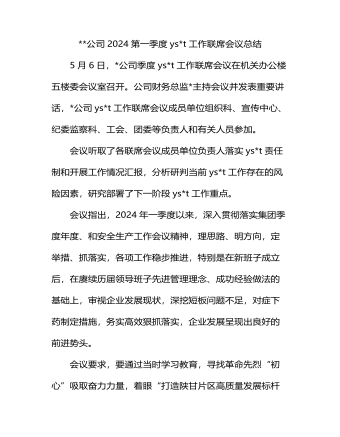
公司2024第一季度意识形态工作联席会议总结
一是要把好正确导向。严格落实主体责任,逐条逐项细化任务,层层传导压力。要抓实思想引领,把理论学习贯穿始终,全身心投入主题教育当中;把理论学习、调查研究、推动发展、检视整改等有机融合、一体推进;坚持学思用贯通、知信行统一,努力在以学铸魂、以学增智、以学正风、以学促干方面取得实实在在的成效。更加深刻领会到******主义思想的科学体系、核心要义、实践要求,进一步坚定了理想信念,锤炼了政治品格,增强了工作本领,要自觉运用的创新理论研究新情况、解决新问题,为西北矿业高质量发展作出贡献。二是要加强应急处事能力。认真组织开展好各类理论宣讲和文化活动,发挥好基层ys*t阵地作用,加强分析预警和应对处置能力,提高发现力、研判力、处置力,起到稳定和引导作用。要坚决唱响主旋律,为“打造陕甘片区高质量发展标杆矿井”、建设“七个一流”能源集团和“精优智特”新淄矿营造良好的舆论氛围。三是加强舆情的搜集及应对。加强职工群众热点问题的舆论引导,做好舆情的收集、分析和研判,把握时、度、效,重视网上和网下舆情应对。
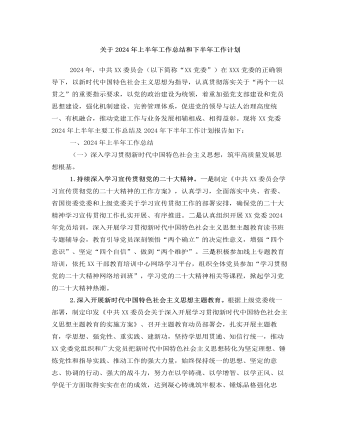
关于2024年上半年工作总结和下半年工作计划
二是深耕意识形态。加强意识形态、网络舆论阵地建设和管理,把握重大时间节点,科学分析研判意识形态领域情况,旗帜鲜明反对和抵制各种错误观点,有效防范处置风险隐患。积极响应和高效落实上级党委的决策部署,确保执行不偏向、不变通、不走样。(二)全面深化党的组织建设,锻造坚强有力的基层党组织。一是提高基层党组织建设力量。压实党建责任,从政治高度检视分析党建工作短板弱项,有针对性提出改进工作的思路和办法。持续优化党建考核评价体系。二是纵深推进基层党建,打造坚强战斗堡垒。创新实施党建工作模式,继续打造党建品牌,抓实“五强五化”党组织创建,广泛开展党员教育学习活动,以实际行动推动党建工作和经营发展目标同向、部署同步、工作同力。三是加强高素质专业化党员队伍管理。配齐配强支部党务工作者,把党务工作岗位作为培养锻炼干部的重要平台。
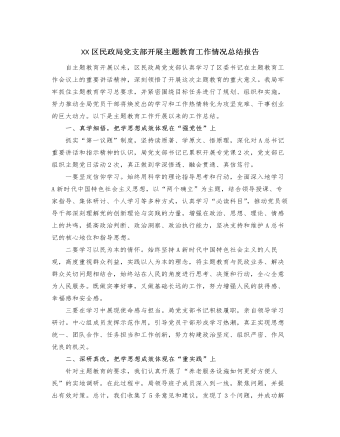
XX区民政局党支部开展主题教育工作情况总结报告
二要专注于解决问题。根据市委促进经济转型的总要求,聚焦“四个经济”和“双中心”的建设,深入了解基层科技工作、学术交流、组织建设等方面的实际情况,全面了解群众的真实需求,解决相关问题,并针对科技工作中存在的问题,采取实际措施,推动问题的实际解决。三要专注于急难愁盼问题。优化“民声热线”,推动解决一系列基层民生问题,努力将“民声热线”打造成主题教育的关键工具和展示平台。目前,“民声热线”已回应了群众的8个政策问题,并成功解决其中7个问题,真正使人民群众感受到了实质性的变化和效果。接下来,我局将继续深入学习主题教育的精神,借鉴其他单位的优秀经验和方法,以更高的要求、更严格的纪律、更实际的措施和更好的成果,不断深化主题教育的实施,展现新的风貌和活力。
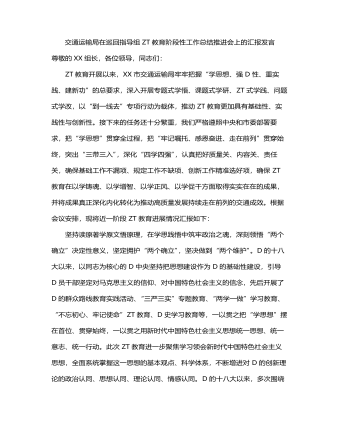
交通运输局在巡回指导组主题教育阶段性工作总结推进会上的汇报发言
今年3月,市政府出台《关于加快打造更具特色的“水运XX”的意见》,提出到2025年,“苏南运河全线达到准二级,实现2000吨级舶全天候畅行”。作为“水运XX”建设首战,谏壁闸一线闸扩容工程开工在即,但项目开工前还有许多实际问题亟需解决。结合“到一线去”专项行动,我们深入到谏壁闸一线,详细了解工程前期进展,实地察看谏壁闸周边环境和舶通航情况,不断完善施工设计方案。牢牢把握高质量发展这个首要任务,在学思践悟中开创建功之业,坚定扛起“走在前、挑大梁、多做贡献”的交通责任,奋力推动交通运输高质量发展持续走在前列。以学促干建新功,关键在推动高质量发展持续走在前列。新时代中国特色社会主义思想着重强调立足新发展阶段、贯彻新发展理念、构建新发展格局,推动高质量发展,提出了新发展阶段我国经济高质量发展要坚持的主线、重大战略目标、工作总基调和方法论等,深刻体现了这一思想的重要实践价值。
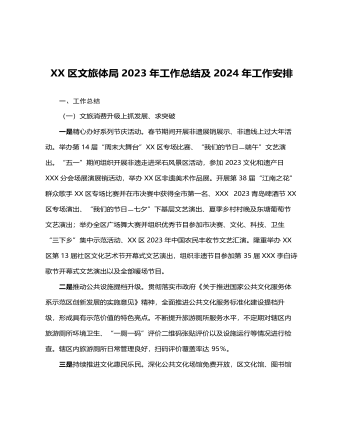
XX区文旅体局2023年工作总结 及2024年工作安排
三、2024年工作计划一是完善基层公共文化服务管理标准化模式,持续在公共文化服务精准化上探索创新,围绕群众需求,不断调整公共文化服务内容和形式,提升群众满意度。推进乡镇(街道)“114861”工程和农村文化“121616”工程,加大已开展活动的上传力度,确保年度目标任务按时保质保量完成。服务“双减”政策,持续做好校外培训机构审批工作,结合我区工作实际和文旅资源优势,进一步丰富我市义务教育阶段学生“双减”后的课外文化生活,推动“双减”政策走深走实。二是结合文旅产业融合发展示范区,全力推进全域旅游示范区创建,严格按照《国家全域旅游示范区验收标准》要求,极推动旅游产品全域布局、旅游要素全域配置、旅游设施全域优化、旅游产业全域覆盖。
今日更新Word
-

精选高中生期末评语
1、该生学习态度端正 ,能够积极配合老师 ,善于调动课堂气氛。 能够积极完成老师布置的任务。学习劲头足,听课又专注 ,做事更认 真 ,你是同学们学习的榜样。但是,成绩只代表昨天,并不能说明你 明天就一定也很优秀。所以,每个人都应该把成绩当作自己腾飞的起 点。2、 你不爱说话 ,但勤奋好学,诚实可爱;你做事踏实、认真、为 人忠厚 ,是一个品行端正、有上进心、有良好的道德修养的好学生。在学习上,积极、主动,能按时完成老师布置的作业,经过努力 ,各 科成绩都有明显进步,你有较强的思维能力和学习领悟力,学习也有 计划性,但在老师看来,你的潜力还没有完全发挥出来,学习上还要有持久的恒心和顽强的毅力。
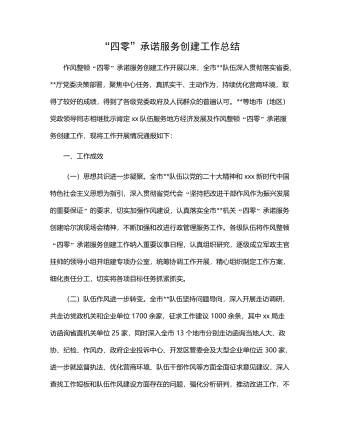
“四零”承诺服务创建工作总结
(二)坚持问题导向,持续改进工作。要继续在提高工作效率和服务质量上下功夫,积极学习借鉴其他部门及xx关于“四零”承诺服务创建工作的先进经验,同时主动查找并着力解决困扰企业和群众办事创业的难点问题。要进一步探索创新,继续优化工作流程,精简审批程序,缩短办事路径,压缩办理时限,深化政务公开,努力为企业当好“保姆”,为群众提供便利,不断适应新时代人民群众对政务服务的新需求。(三)深化内外宣传,树立良好形象。要深入挖掘并及时总结作风整顿“四零”承诺服务创建工作中形成的典型经验做法,进一步强化内部宣传与工作交流,推动全市创建工作质效整体提升。要面向社会和公众庄严承诺并积极践诺,主动接受监督,同时要依托电台、电视台、报纸及微信、微博等各类媒体大力宣传xx队伍作风整顿“四零”承诺服务创建工作成果,不断扩大社会知情面和群众知晓率。
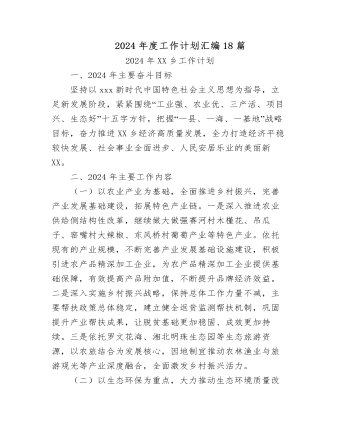
2024年度工作计划汇编(18篇)
1.市政基础设施项目5项,总建设里程2.13km,投资概算2.28亿元。其中,烔炀大道(涉铁)工程施工单位已进场,项目部基本建成,正在办理临时用地、用电及用水等相关工作;中铁佰和佰乐(巢湖)二期10KV外线工程已签订施工合同;黄麓镇健康路、纬四路新建工程均已完成清单初稿编制,亟需黄麓镇完成图审工作和健康路新建工程的前期证件办理;公安学院配套道路项目在黄麓镇完成围墙建设后即可进场施工。2.公益性建设项目6项,总建筑面积15.62万㎡,投资概算10.41亿元。其中,居巢区职业教育中心新建工程、巢湖市世纪新都小学扩建工程已完成施工、监理招标挂网,2月上旬完成全部招标工作;合肥职业技术学院大维修三期已完成招标工作,近期签订施工合同后组织进场施工;半汤疗养院净化和医用气体工程已完成招标工作;半汤疗养院智能化工程因投诉暂时中止;巢湖市中医院(中西医结合医院)新建工程正在按照既定计划推进,预计4月中下旬挂网招标。

驻村工作队2024年第一季度工作总结汇编(4篇)
三是做大做强海产品自主品牌。工作队于xx年指导成立的冬松村海产品合作社,通过与消费帮扶平台合作,在工作队各派出单位、社会团体、个人支持下,已获得逾xx万元销售额。2022年底工作队推动合作社海产品加工点扩建的工作方案已获批,待资金下拨后将正式启动扩建工作。四是积极助企纾困,带动群众增收致富。工作队利用去年建立的xx镇产业发展工作群,收集本地企业在产品销售、技术、人力、资金、运营、用地等方面的需求,并加大xx支持乡村振兴力度,xx助理赴各村委开展多场xx政策支持乡村振兴宣讲活动,本季度有x万元助农贷款获批,xx万贷款正在审批中。在壮大既有产业的同时,完善联农带农机制,一方面鼓励企业雇用本地农户就业,另一方面计划与本地农户签订长期收购合同,让农民种得放心、种得安心,带动当地群众共同致富。

主题教育总结常用提纲大全
第一,主题教育是一次思想作风的深刻洗礼,初心传统进一步得到回归。第二,主题教育是一次沉疴积弊的集中清扫,突出问题进一步得到整治。第三,主题教育是一次强化为民服务的生动实践,赤子之情进一步得到提振。第四,主题教育是一次激发创业担当的有利契机,发展层次进一步得到提升。2.第一,必须提领思想、武装思想。第二,必须聚焦问题、由表及里。第三,必须领导带头、以上率下。第四,必须务实求实、认真较真。3.一是抬高政治站位,坚持大事大抓。二是坚持思想领先,狠抓学习教育。三是突出问题导向,深入整改纠治。四是坚持领导带头,发挥表率作用。4.一是立足“早”字抓筹划。二是着眼“活”字抓学习。三是围绕“统”字抓协调。5.一是形势所需。二是任务所系。三是职责所在。四是制度所定。6.一要提升认识。二要积极作为。三要密切协作。
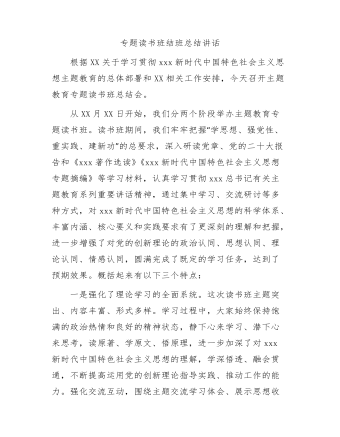
主题教育专题读书班结班总结讲话
第二,要把调查研究贯穿始终,实干担当促进发展。开展好“察实情、出实招”“破难题、促发展”“办实事、解民忧”专项行动,以强化理论学习指导发展实践,以深化调查研究推动解决发展难题。领导班子成员要每人牵头XX个课题开展调查研究,XX月底前召开调研成果交流会,集思广益研究对策措施。各部门、各单位要制定调研计划,通过座谈访谈、问卷调查、统计分析等方式开展调查研究,解决工作实际问题,帮助基层单位和客户解决实际困难。第三,要把检视问题贯穿始终,廉洁奉公树立新风。认真落实公司主题教育整改整治工作方案要求,坚持边学习、边对照、边检视、边整改,对标对表xxx新时代中国特色社会主义思想,深入查摆不足,系统梳理调查研究发现的问题、推动发展遇到的问题、群众反映强烈的问题,结合巡视巡察、审计和内外部监督检查发现的问题,形成问题清单。

















